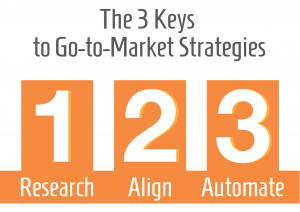A manufacturing revolution is here. It’s disrupting the value chain, from product innovation to customer loyalty. And many are calling it the next Industrial Revolution – one filled with not just technology, but with smarter technology.
There’s no doubt: B2B or B2C, the way customers buy has fundamentally changed. And go-to-market strategies need to keep up. You might be wondering, “How does my organization make this transformational change when we have more external pressures than ever and time to market is crucial?” Well, here’s where to start.
There are three fundamental decisions you can make.
1. Research and understand your customer’s journey.
- Who are your customers?
- Why do they really buy your product?
- What do they do with it?
- What is their perception of your brand?
- What does the customer want at each stage of the buying journey, from awareness to loyalty?
All of these questions and more are critical to garnering a clear picture of the customer journey and how your go-to-market strategies can align with it. Whether you’re launching a new product or bringing a product enhancement to market, aligning your strategy with the journey will optimize the experience for both your organization and your customer. Plus, it will accelerate time to market, which can directly impact your bottom line.
2. Align your organization with the journey.
The customer journey expands across many business functions. It starts with product innovation, continues all the way through service, and repeats. This requires organization alignment as well (and I do mean requires).
By bringing business groups (e.g., engineering, marketing, sales and service) together in alignment with technology and finance, you can span across all aspects of the customer journey. That creates cohesive alignment and expertise to optimize your go-to-market strategy.
Case in Point: Nordstrom’s Results
In fact, this has been proven successful in many industries, such as retail. For example, Nordstrom’s has demonstrated their ability to bring new concepts to their customers rapidly and with results. According to Jim Howell, Executive VP of Finance at PricewaterhouseCoopers, this has “… enabled quicker evaluations and nimbler adjustments that maximize the positive impact on customers, better manage costs and improve the Nordstrom brand in the marketplace.”
3. Streamline, automate and repeat.
You’ve successfully aligned your organization with the customer’s journey. Now what? The right use of technology becomes your golden ticket to making data-driven decisions and automating your go-to-market strategies.
When making technology investments, think about how you plan to optimize the customer experience across all touchpoints. Data collection, aggregation and interpretation will be crucial. But with the proper aggregation tools and interpretation methods, your data becomes actionable – enabling your organization to innovate and rapidly exploit current and new revenue opportunities, much quicker than your competition.
So, what have we covered? Well, having a good go-to-market strategy is one thing, but automating it becomes your competitive differentiator. Remember, it comes down to three steps: research your customer journey, align your organization to it, and automate whenever possible to deliver more value.
The pressures on the manufacturing industry aren’t going anywhere. But neither are the opportunities. Instead of resisting, seize your chances to innovate. And if you aren’t sure where to start, we’re here to help.



